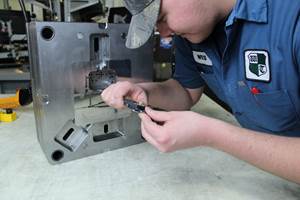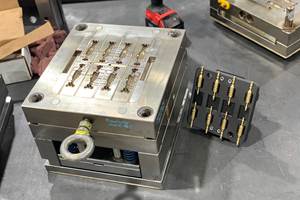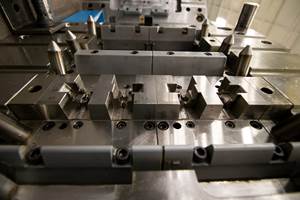Are All Graphites Created Equal?
Five key performance factors to consider when selecting your graphite grade.
Following are the five key performance factors that measure a graphite's worth
to the EDM'er.
1. Wear Resistance
Wear on the graphite electrode occurs when graphite particles are eroded during the EDM process. How does this occur? In conventionally produced graphites the damaging effect of the EDM process eventually dislodges particles from the sur-face of the electrode. As losses accumulate the dimensions of the electrode begin to change. This phenomenon occurs regardless of the manufacturing techniques employed in conventionally produced graphites.
New technologies have recently been developed—and are now successfully being employed—that significantly limit these damaging effects. This is being accomplished through a technology that bonds the individual particles into unique bundles of particles that resist the damaging effects of the EDM process on the surface of the electrode. This newer technology uses a bundling process to join discrete particles together into a more cohesive mass. The effect is that erosion of these newer technology graphites occurs primarily at the molecular level and at a much slower rate than with conventionally manufactured, particle-to-particle bonded graphites.
2. Surface Finish
Surface finish is directly related to the effective particle size of the graphite. In conventionally produced graphites the effective size of the particles and the actual size of the particles are essentially the same; however, in graphites using the newer bundled technology there is an effective particle size that is smaller than the actual particle size. Thus, a grade with an actual particle size of four microns for example will develop an effective particle size more like a two- or three-micron graphite. The result of this phenomenon is that a surface finish can be achieved that is finer and more consistent than would be expected from the four-micron graphite.
3. Metal Removal Rate
Metal removal rate is dependent on the particle size of the graphite used to make the electrode. Today there are a variety of grades of graphite available on the market to provide the performance an EDM'er needs. It must be remembered that in positive polarity the larger the particle size, the faster the metal removal rate one can achieve. Thus an EDM'er needs to consider whether an ultra-premium (<5µ particle size), premium (5-7µ particle size), or superfine (8-15µ particle size) grade is the right one to use. Fortunately there are many grades of graphite, from many manufacturers, offered today with particle sizes in these ranges.
When considering graphite grades an EDM'er must remember that a particularly key feature of the newer bundled technology graphite is the ability to provide improved current flow within the electrode. Conventionally produced graphites with their high degree of open porosity and separate particle-to-particle bonding create extended current paths that rob the spark of energy as it passes through the electrode. This can be observed in the form of energy loss through the development of excessive heating of the electrode. The bundled technology graphites have less heat generation, and pass more of the energy through to the area where it is needed—in the gap—to provide the most efficient EDMing available.
4. Graphite Machining
The most relevant factors in electrode fabrication are the strength and hardness of the material being cut. High strength is often achieved by slightly changing the manufacturing process. An undesirable effect that many times occurs with the increased strength is an increase in the hardness of the graphite.
In the newer generation of graphites using the bundled technology, high graphite strength is achieved at surprisingly low hardness values. Together the properties will provide a material that is very machinable, and yet produces thin ribs or other highly detailed features without fear of chipping or cracking of the graphite.
5. Cost of the Graphite
Cost of graphites can be extremely confusing to the purchaser. Most graphites are sold through various distribution channels and the end user prices can vary widely. Generally the end user makes his purchasing decisions based upon personal experience with the graphite and the service level that he receives.
It must be noted however that the price of the graphite itself should normally be a small consideration in the purchasing decision. Of far greater importance are the results observed from the other four of the five key performance factors noted above. Pricing of graphite should only come into play after the particular grade requirements have been well determined through a thorough evaluation of the wear resistance, surface finish, metal removal rate and the machinability of the graphite.
Conclusion
The EDM'er today is forced to consistently make good decisions when selecting his electrode material. Luckily he has a tool to guide him in his evaluations. The five key performance factors have proven to be a time tested way to do his evaluations. The good news for the EDM'er is that the performance factors have shown repeatedly that new technology, one featuring the bundling of discrete graphite particles, provides the end user with superior results when compared to conventionally manufactured graphites using individual particle-to-particle bonding techniques.
Related Content
Machining and EDM Innovations to Look for at IMTS
MoldMaking Technology previews some of the EDM and machining products and exhibitors applicable to mold builders that will be featured at IMTS 2022.
Read MoreMachine Monitoring Platform Improves Machine Utilization, On-Time Delivery
Using data from a machine monitoring platform, Westminster Tool added almost 75 hours of capacity per week by shortening warmups and starting CNC and EDM machines sooner.
Read MoreSmall, Agile Mold Builder Keeps Speed and Accuracy at the Forefront
Michigan-based Zero Tolerance tests the limits of moldmaking and molding with teamwork and technology that permits changes on the fly.
Read MoreExtensive Evaluations Build The Plastek Group’s EDM Arsenal
Sinker and wire EDMs selected for speed, volumetric accuracy, surface finish, reliability, cost of ownership and extensive warranty.
Read MoreRead Next
Reasons to Use Fiber Lasers for Mold Cleaning
Fiber lasers offer a simplicity, speed, control and portability, minimizing mold cleaning risks.
Read MoreHow to Use Strategic Planning Tools, Data to Manage the Human Side of Business
Q&A with Marion Wells, MMT EAB member and founder of Human Asset Management.
Read More
















_300x250 4.png;maxWidth=300;quality=90)






